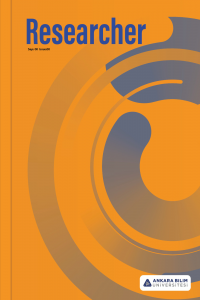Türkiye’de Sağlık Hizmetlerinde Sosyal Medya Kullanımı: Kamu Hastaneleri Örneği
Sosyal medya Sağlık hizmetleri Kamu hastaneleri İletişim
The Use of Social Media by Health Services in Turkey: Sample of Public Hospitals
___
- An R., Ji M., Zhang S. (2017). Effectiveness of Social Media-based Interventions on Weightrelated Behaviors and Body Weight Status: Review and Meta-analysis, Am J. Health Behav, 41(6):670-682.
- Andzulis JM., Panagopoulos NG & Rapp A. (2012). A Review of Social Media and Implications for the Sales Process, Journal of Personal Selling & Sales Management, 32(3):305-316.
- Bacigalupe G. (2011). Is There a Role for Social Technologies in Collaborative Healthcare? Families, Systems & Health, 29(1):1-14.
- Carr CT., Hayes RA. (2015). Social Media: Defining, Developing and Divining, Atlantic Journal of Communication, 23(1):46-65.
- Chen YL, Chang CL., Yeh CS. (2017). Emotion Classification of Youtube Videos, Decision Support Systems, 101(2017):40-50.
- Ferchaud A., Grzeslo J., Orme S., LaGroue. (2018). Parasocial Attributes and Youtube Personalities: Exploring Content Trends Across the Most Subscribed Youtube Channels, Computers in Human Behavior, 80(2018):88-96.
- Forbat L., Cayless S., Knighting K., Cornwell J. & Kearneya N. (2009). Engaging Patients in Health Care:An Ampirical Study of the Role of Engagement on Attitudes and Action, Patient Education and Counseling, 74(1):84-90.
- Glassman ME., Straus JR. & Shogan CJ. (2010). Social Networking and Constituent Communication:Member Use of Twitter During a Two-Week Period in the 111th Congress, USA:DIANE Publishing.
- Guo X., Wei Q., Chen G. (2017). Extracting Representative Information on IntraOrganizational Blogging Platforms, MIS Quarterly, 41(4):1105-1127.
- Heinonen K. (2011). Consumer Activity in Social Media:Managerial Approaches to Consumers’ Social Media Behavior, Journal of Consumer Behaviour, 10(6):356-364.
- Heo GM., Lee Romee. (2013). Blogs and Social Network Sites as Activity Systems: Exploring Adult Informal Learning Process through Activity Theory Framework, Educational Technology and Society, 16(4):133-145.
- Hughes DJ., ROWE M., Batey M., & Lee A. (2012). A Tale of Two Sites: Twitter vs. Facebook and the Personality Predictors of Social Media Usage, Computers in Human Behavior, 28(2), 561-569.
- Kanavos A., Nodarakis N., Sioutas S., Tsakalidis A., Tsolis D. & Tzimas G. (2017). Large Scale Implementations for Twitter Sentiment Classification, Algorithms, 10(1):1-21.
- Kaplan AM., Haenlein M. (2010). Users of the World, Unite! The Challanges and Opportunities of Social Media, Business Horizons, 53(1):59-68.
- Kelleher T., Miller BM. (2006). Organizational Blogs and the Human Voice: Relational Strategies and Relational Outcomes, Journal of Computer-Mediated Communication, 11(2):395-414.
- Lawson-Borders G. (2005). Blogs in Campaign Communication, American Behavioral Scientist, 49(4):548-559.
- Lemel R. (2014). A Framework for Developing a Taxonomy of Social Media, Business Studies Journal, 6(1):67-80.
- Luo X., Gu B., Zhang J., & Phang CW. (2017). Expert Blogs and Consumer Perceptions of Competing Brands, MIS Quarterly, 41(2):371-395.
- Malik H., Tian Z. (2017). A Framework for Collecting Youtube Meta-Data, Procedia Computer Science, 113(2017):194-201.
- Przepiorka A., Blachnio A., Diaz-Moralez JF. (2016). Problematic Facebook Use and Procrastination, Computers in Human Behavior, 65(2016):59-64.
- Ryan T., Xenos X. (2011). Who Uses Facebook? An Investigation into the Relationship Between The Big Five, Shyness, Narcissism, Loneliness and Facebook Usage, Computers in Human Behavior, 27(5):1658-1664.
- Thackeray R., Neiger B., Hanson C. & McKenzie J. (2008). Enhancing Promotional Strategies within Social Marketing Programs:Use of Web 2.0 Social Media, Health Promotion Practice, 9(4):338-343.
- Van de Belt TH., Berben SA., Samsom M., Engelen LJ., Schoonhoven L. (2012). Use of Social Media by Western European Hospitals: Longitudinal Study, Journal of Medical Internet Research 14(3):e61.doi:10.2196/jmir.1992.
- Waters RD., Jamal JY. (2011). Tweet, Tweet, Tweet: A Content Analysis of Nonprofit Organizations’ Twitter Updates, Public Relations Review, 37(3), 321-324.
- Wong CA., Ostapovich G., Kramer-Golinkoff E., Griffis H., Asch DA. & Merchant RM. (2016). How U.S. Children’s Hospitals Use Social Media: A Mixed Methods Study, Healthcare, 4(2016):15-21.
- Young NL., Kuss DJ., Griffiths MD., Howard CJ. (2017). Passive Facebook Use, Facebook Addiction and Associations with Escapism: An Experimental Vignette Study, Computers in Human Behavior, 71(2017):24-31.
- Zhang X., Xia Z. & Bu Z. (2014). Popularity Evaluation Model for Microbloggers Online Social Network, Discrete Dynamics in Nature and Society, 2014(1):1-12.
- Distribution of Social Media Used in Turkey 2016-2017. https://www.statista.com/statistics/570098/distribution-of-social-media-used-turkey/ (Erişim Tarihi: 15.02.2018)
- Global Social Networks Ranked by Number of Users 2018. https://www.statista.com/statistics/272014/global-social-networks-ranked-by-number-ofusers/ (Erişim Tarihi: 15.02.2018)
- ISSN: 2717-9494
- Yayın Aralığı: Yılda 2 Sayı
- Başlangıç: 2013
- Yayıncı: Ankara Bilim Üniversitesi
Sibel OĞUZ HAÇAT, Maksut ÖNLEN, Mehmet TATAN, F Betül DEMİR
Amerika’da Anne-Baba Eğitiminde Uygulanan Erken Müdahale Programları
Bireysel Emeklilik Şirketlerinin Pazarlama Sorunları ve Tüketicilerin Tutumları
Derya ÇAKIR, Murat Selim SELVİ
Türk Atasözlerinde Merak Kavramı
Öğretmenlerin Örgütsel Adalet Algıları ile Motivasyon Düzeyleri Arasındaki İlişki
Çanakkale Muharebelerinde Şehit Olan Dinarlılar
Aslı AKMAN YOZGAT, Neslihan ÖZBEK, Özlem AFACAN
Türkiye’de Sağlık Hizmetlerinde Sosyal Medya Kullanımı: Kamu Hastaneleri Örneği
Sosyal Uyum ile Psikolojik Belirti Arasındaki İlişkide Sosyal Yetkinlik İnancının Aracılık Rolü
Öner ÇELİKKALELİ, Mim Sertaç TÜMTAŞ
Yabancı Dil Öğretiminde Yaratıcı Drama: Öğrenci Ürünleri ve Görüşleri Üzerine Nitel Bir Çalışma
